Genetic diversity and evolution of the emerging picornavirus Senecavirus A

Abstract
Senecavirus A (SVA) is an emerging picornavirus that causes vesicular disease (VD) in swine. The virus has been circulating in swine in the United Stated (USA) since at least 1988, however, since 2014 a marked increase in the number of SVA outbreaks has been observed in swine worldwide. The factors that led to the emergence of SVA remain unknown. Evolutionary changes that accumulated in the SVA genome over the years may have contributed to the recent increase in disease incidence. Here we compared full-genome sequences of historical SVA strains (identified before 2010) from the USA and global contemporary SVA strains (identified after 2011). The results from the genetic analysis revealed 6.32% genetic divergence between historical and contemporary SVA isolates. Selection pressure analysis revealed that the SVA polyprotein is undergoing selection, with four amino acid (aa) residues located in the VP1 (aa 735), 2A (aa 941), 3C (aa 1547) and 3D (aa 1850) coding regions being under positive/diversifying selection. Several aa substitutions were observed in the structural proteins (VP1, VP2 and VP3) of contemporary SVA isolates when compared to historical SVA strains. Some of these aa substitutions led to changes in the surface electrostatic potential of the structural proteins. This work provides important insights into the molecular evolution and epidemiology of SVA.